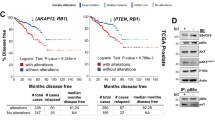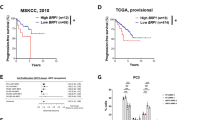Abstract
Breast tumor kinase (BRK) is an intracellular tyrosine kinase expressed in differentiating epithelial cells of the gastrointestinal tract and skin, and in several epithelial cancers including carcinomas of the breast and colon. We examined expression of BRK and its mouse ortholog Src-related intestinal kinase (Sik) in prostate tissues and detected it in the nuclei of normal luminal prostate epithelial cells. BRK localization was then examined in 58 human prostate biopsy samples representing various grades of prostate cancer. While nuclear localization of BRK was present in well-differentiated tumors, it was absent in poorly differentiated tumors. However localization of Sam68, a nuclear substrate of BRK/Sik, was unaltered in all prostate tumors examined. Consistent with these results, nuclear BRK was detected in the more differentiated androgen-responsive LNCaP human prostate cancer cell line that is poorly tumorigenic in host animals, but it was primarily cytoplasmic in the undifferentiated androgen-unresponsive PC3 prostate cancer cell line that forms aggressive tumors. While PC3 cells expressed higher levels of endogenous BRK than LNCaP cells, BRK was less active in these cells. Our data suggest that BRK plays a role in differentiation of prostate epithelial cells. Altered BRK localization and/or activity may provide a prognostic indicator for prostate tumor progression and be a potential target for therapeutic intervention.
This is a preview of subscription content, access via your institution
Access options
Subscribe to this journal
Receive 50 print issues and online access
$259.00 per year
only $5.18 per issue
Buy this article
- Purchase on Springer Link
- Instant access to full article PDF
Prices may be subject to local taxes which are calculated during checkout









Similar content being viewed by others
References
Abate-Shen C and Shen MM . (2000). Genes Dev., 14, 2410–2434.
Barker KT, Jackson LE and Crompton MR . (1997). Oncogene, 15, 799–805.
Barlat I, Maurier F, Duchesne M, Guitard E, Tocque B and Schweighoffer F . (1997). J. Biol. Chem., 272, 3129–3132.
Blume-Jensen P and Hunter T . (2001). Nature, 411, 355–365.
Chen T, Boisvert FM, Bazett-Jones DP and Richard S . (1999). Mol. Biol. Cell, 10, 3015–3033.
Coyle JH, Guzik BW, Bor YC, Jin L, Eisner-Smerage L, Taylor SJ, Rekosh D and Hammarskjold ML . (2003). Mol. Cell. Biol., 23, 92–103.
Denegri M, Chiodi I, Corioni M, Cobianchi F, Riva S and Biamonti G . (2001). Mol. Biol. Cell, 12, 3502–3514.
Derry JJ, Richard S, Valderrama Carvajal H, Ye X, Vasioukhin V, Cochrane AW, Chen T and Tyner AL . (2000). Mol. Cell. Biol., 20, 6114–6126.
Djakiew D . (2000). Prostate, 42, 150–160.
Easty DJ, Mitchell PJ, Patel K, Florenes VA, Spritz RA and Bennett DC . (1997). Int. J. Cancer, 71, 1061–1065.
Feldman BJ and Feldman D . (2001). Nature Rev. Cancer, 1, 34–45.
Gleason DF and Mellinger GT . (1974). J. Urol., 111, 58–64.
Hartmann AM, Nayler O, Schwaiger FW, Obermeier A and Stamm S . (1999). Mol. Biol. Cell, 10, 3909–3926.
Hellawell GO and Brewster SF . (2002). BJU Int., 89, 230–240.
Horoszewicz JS, Leong SS, Chu TM, Wajsman ZL, Friedman M, Papsidero L, Kim U, Chai LS, Kakati S, Arya SK and, Sandberg AA . (1980). Prog. Clin. Biol. Res., 37, 115–132.
Kaighn ME, Narayan KS, Ohnuki Y, Lechner JF and Jones LW . (1979). Invest Urol., 17, 16–23.
Lee ST, Strunk KM and Spritz RA . (1993). Oncogene, 8, 3403–3410.
Lim DJ, Liu XL, Sutkowski DM, Braun EJ, Lee C and Kozlowski JM . (1993). Prostate, 22, 109–118.
Llor X, Serfas MS, Bie W, Vasioukhin V, Polonskaia M, Derry J, Abbott CM and Tyner AL . (1999). Clin. Cancer Res., 5, 1767–1777.
Matter N, Herrlich P and Konig H . (2002). Nature, 420, 691–695.
Mitchell PJ, Barker KT, Martindale JE, Kamalati T, Lowe PN, Page MJ, Gusterson BA and Crompton MR . (1994). Oncogene, 9, 2383–2390.
Mitchell PJ, Sara EA and Crompton MR . (2000). Oncogene, 19, 4273–4282.
Reddy TR, Xu W, Mau JK, Goodwin CD, Suhasini M, Tang H, Frimpong K, Rose DW and Wong-Staal F . (1999). Nat. Med., 5, 635–642.
Resnick RJ, Taylor SJ, Lin Q and Shalloway D . (1997). Oncogene, 15, 1247–1253.
Siyanova EY, Serfas MS, Mazo IA and Tyner AL . (1994). Oncogene, 9, 2053–2057.
Soros VB, Carvajal HV, Richard S and Cochrane AW . (2001). J. Virol., 75, 8203–8215.
Vasioukhin V, Serfas MS, Siyanova EY, Polonskaia M, Costigan VJ, Liu B, Thomason A and Tyner AL . (1995). Oncogene, 10, 349–357.
Vasioukhin V and Tyner AL . (1997). Proc. Natl. Acad. Sci. USA, 94, 14477–14482.
Vernet C and Artzt K . (1997). Trends Genet., 13, 479–484.
Acknowledgements
This work was supported by the National Institutes of Health Grants DK44525 (ALT) and NIDDK 40890 (GSP).
Author information
Authors and Affiliations
Corresponding author
Rights and permissions
About this article
Cite this article
Derry, J., Prins, G., Ray, V. et al. Altered localization and activity of the intracellular tyrosine kinase BRK/Sik in prostate tumor cells. Oncogene 22, 4212–4220 (2003). https://doi.org/10.1038/sj.onc.1206465
Received:
Revised:
Accepted:
Published:
Issue Date:
DOI: https://doi.org/10.1038/sj.onc.1206465
Keywords
This article is cited by
-
PTK6 inhibits autophagy to promote uveal melanoma tumorigenesis by binding to SOCS3 and regulating mTOR phosphorylation
Cell Death & Disease (2023)
-
METTL3 preferentially enhances non-m6A translation of epigenetic factors and promotes tumourigenesis
Nature Cell Biology (2022)
-
PSPC1 is a new contextual determinant of aberrant subcellular translocation of oncogenes in tumor progression
Journal of Biomedical Science (2021)
-
PSPC1-interchanged interactions with PTK6 and β-catenin synergize oncogenic subcellular translocations and tumor progression
Nature Communications (2019)
-
MicroRNA-214 targets PTK6 to inhibit tumorigenic potential and increase drug sensitivity of prostate cancer cells
Scientific Reports (2019)



